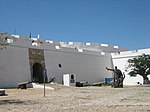World Heritage in Angola
The World Heritage in Angola (as of 2017) includes a UNESCO World Heritage Site. Angola ratified the World Heritage Convention in 1991, and the only World Heritage site to date was added to the World Heritage List in 2017.
World heritage sites
The following table lists the UNESCO World Heritage Sites in Angola in chronological order according to the year of their inclusion on the World Heritage List (K - cultural heritage, N - natural heritage, K / N - mixed, (R) - on the Red List of World Heritage in Danger ).
![]() Map with all coordinates of the World Heritage Sites: OSM
Map with all coordinates of the World Heritage Sites: OSM
| image | designation | year | Type | Ref. | description |
|---|---|---|---|---|---|
|
Mbanza Kongo, relics of the capital of the former Kingdom of the Congo ( location ) |
2017 | K | 1511 | The ruins of the royal city of M'banza Kongo from the time it was the capital of the Kingdom of Congo have been a listed building since 1957. |
Tentative list
The sites that are intended for nomination for inclusion in the World Heritage List are entered in the tentative list . Currently (2017) 13 sites are entered in the tentative list of Angola, the last entry was in 2017. The following table lists the sites in chronological order according to the year they were included in the tentative list (K - cultural heritage, N - natural heritage, K / N - mixed).
![]() Map with all coordinates of current World Heritage candidates: OSM
Map with all coordinates of current World Heritage candidates: OSM
| image | designation | year | Type | Ref. | description |
|---|---|---|---|---|---|
|
São Miguel Fortress ( location ) |
1996 | K | 921 | The first Portuguese fortress in Angola, built in 1576, is now a landmark of the capital Luanda | |
| São Pedro da Barra fortress | 1996 | K | 922 | The poorly preserved fortress, built in 1703, is located in the municipality of Ngola Kiluanje in Luanda and has been a listed building since 1932. | |
| Sao Francisco do Penedo Fortress | 1996 | K | 923 | The fortress in Luanda was built under Philip II in 1765/66 and is poorly preserved today. | |
| Massangano fortress | 1996 | K | 924 | The fortress of Massangano was built in 1583 and has been a listed building since 1923. | |
| Church of Nossa Senhora da Victoria | 1996 | K | 925 | The church in Massangano , built between 1583 and 1590, has been a listed building since 1928 | |
| Cambambe Fortress | 1996 | K | 926 | The fortress of Cambambe, built in 1604, has been a listed building since 1925, but is now in an advanced state of deterioration. | |
| Fortress of Muxima | 1996 | K | 927 | The fortress of Muxima was built in 1599. It has been a listed building since 1924, but has been poorly preserved. | |
| Church of Nossa Senhora da Conceição da Muxima | 1996 | K | 928 | The church in Muxima , built for the first time in 1599, is now the most important pilgrimage site in Angola, with around one million pilgrims visiting every year. | |
| Small fortress of Kikombo | 1996 | K | 929 | The small fortress in the Bay of Kikombo ( Cuanza Sul province ) was built in the middle of the 17th century. It is comparatively well preserved and has been a listed building since 1924. | |
| Nossa Senhora do Rosario | 1996 | K | 930 | The church in Cambambe was built in 1603. | |
| Corredor do Kwanza cultural landscape | 2017 | K / N | 6250 | Cultural landscape on the Cuanza river | |
| Tchitundu-Hulu archaeological site | 2017 | K | 6251 | ||
|
Cuito Cuanavale - place of liberation and independence ( ) |
2017 | K | 6252 |
Web links
- Angola on the UNESCO World Heritage Center website.
Individual evidence
- ^ Angola. In: whc.unesco.org. UNESCO World Heritage Center, accessed June 13, 2017 .
- ^ Tentative list of Angola. In: whc.unesco.org. UNESCO World Heritage Center, accessed June 13, 2017 .







